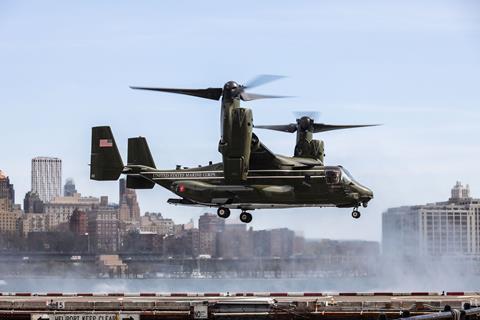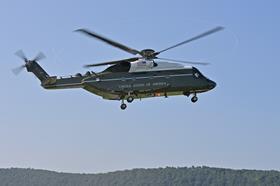A VIP-transport Bell-Boeing V-22 Osprey assigned to the US Marine Corps (USMC) squadron that provides vertical-lift support to the US president has been grounded over unspecified safety concerns in New York.
The tiltrotor had been assigned to ferry White House staff back to Washington, DC from New York City, where President Joe Biden made an appearance on 25 November ahead of the upcoming Thanksgiving holiday in the USA.
A reporter travelling with the White House press corps reportedly observed flames coming from beneath the Osprey’s right engine nacelle during boarding at Miller Field on Staten Island, prompting the grounding of that aircraft.
Staff were transferred to another aircraft for movement to New York’s John F Kennedy International airport for a return flight to Washington, with only a minor delay to the travel schedule. The USMC did not immediately respond to a request for comment.

There is no indication that Biden was aboard the aircraft in question. The USMC has previously said that Ospreys assigned to Marine Helicopter Squadron One (HMX-1) carry presidential support staff and news media representatives travelling with the president, but not the commander-in-chief.
HMX-1 operates the fleet of signature green-and-white presidential rotorcraft, which includes 12 MV-22s.
The US president typically travels on one of several Sikorsky VH-3D helicopters – a heavily-modified variant of the SH-3 Sea King that bears the call sign “Marine One” when the president is aboard.

HMX-1 also flies the VH-60 variant of the Sikorsky UH-60 Black Hawk and the latest VH-92A Patriot – a derivative of Sikorsky’s S-92 commercial helicopter. The company delivered the final VH-92A example in August, with Biden making the first-ever presidential flight in the type later that month.
Following the latest Osprey incident, The Associated Press reports that several members of the US Congress have sent a letter to the Pentagon calling for the troubled tiltrotor to be grounded fleet-wide.
Three lawmakers from Massachusetts, including former presidential candidate Elizabeth Warren, previously put that demand in writing in July, in response to the Pentagon lifting a worldwide grounding of the entire V-22 fleet.
“There appears to be a litany of causes of the V-22’s problems that have yet to be resolved to ensure it is safe to fly,” the original letter said.
That flight stoppage was ordered in December 2023 after a deadly CV-22 crash off the coast of Japan that killed eight US Air Force (USAF) personnel. The Pentagon’s airworthiness authority cleared Ospreys to return to limited flight operations in March despite lingering uncertainty about how to prevent the mechanical issue that caused the crash.
Sixty-four US service members have died in Osprey crashes since the tiltrotor’s introduction in 2007, including at least 20 fatalities from four crashes since 2022. Manufacturer Bell and the Pentagon maintain that the V-22’s safety record is actually better than that of other less-scrutinised models when the Osprey’s total flight hours are considered.
The three US military operators of the V-22 have since taken different approaches to operating the tiltrotor.
USMC MV-22s were seen landing on the decks of amphibious assault ships just one month after the grounding was lifted, while the USAF announced in September it was deploying CV-22s to operational combat duty.
The US Navy has been much slower to re-embrace the Osprey. In June, the head of Naval Air Systems Command, which serves as the global airworthiness authority for Ospreys, said he did not expect the V-22 fleet to return to fully unrestricted flight operations until next year.
“We are methodically looking at material and non-material changes that we can make to allow for a full mission set without controls in place,” Admiral Carl Chebi told members of Congress in June. “Based on the data that I have today, I’m expecting that this will not occur until mid-2025.”
The navy operates the CMV-22B variant of the Osprey in the carrier on-board resupply role, providing logistics support to the USA’s gargantuan floating airfields at sea.
That mission requires long flights over water, most of which would violate flight restrictions imposed on Osprey crews after the grounding was lifted. Those include limits on flight time required to reach emergency diversion airfields – less an issue for USAF and USMC crews flying overland routes or shorter ship-to-shore hops.


































